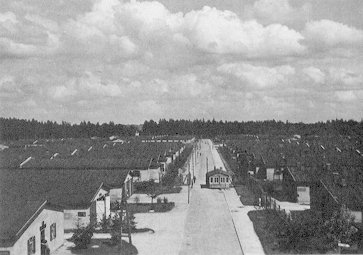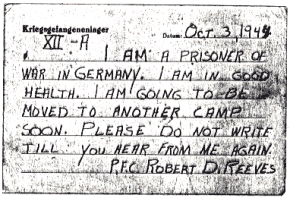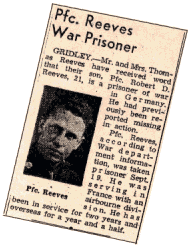

 |
 |
| Stalag VII A: Oral history |
|
Part I: We Arrive at Stalag VII
A Source: |
Guard Towers and Barbed WireBy Robert D. ReevesViewed through the barbed wire mesh, Stalag VII A loomed as a bleak reality of the circumstances in which I now found myself... circumstances I had not allowed myself to dwell upon when I entered the United States Army just 18 months previously. 
The perimeter of the camp, as far as I could see, was a regular pattern of guard towers outfitted with machine guns. These military parapets looked over seemingly impassable barbed wire barriers. The sharp, spiked wire was used to create two 12-foot high walls separated only by more coiled barbed wire. The rows of drab, unpainted, squat buildings that were to become our quarters seemed to stretch into the horizon in a grid of grim neighborhoods, reminding us all of the homes, families, and jobs we had left behind. If we were to be held prisoner in Stalag VII-A for any great length of time, I knew it would be a daily threat to our health, happiness, and human dignity. Stalag VII-A was huge! The very vastness of the camp clouds my recollection of the details. The camp extended well beyond my sight in all directions. I learned later that Stalag VII-A was Germany's largest POW camp, at one time housing over 110,000 Allied troops. This is a greater number of people than currently live in Peoria; Illinois' third largest city - all within a barbed wire enclosure.
The uniformity of the rows of barracks placed consecutively one after another brings to me an image of never-ending parallel lines - despairingly outlined by barbed wire fence. Creating an even more disturbing spectacle, was an area just inside the main gate called the sonder-baracke, which was a special detention area for all the prisoners who had previously escaped from the stalag and had been recaptured. I suspected that no matter how uncomfortable my quarters were about to become, these American patriots in the sonder-baracke were surviving under worse conditions. They pressed against the barbed-wire enclosure begging us for some of what little food we had, and when we tried to oblige them by tossing in few chunks of brot (bread), the guards rushed over to the scraps we threw and ground them into the dirt with their shoes. We Settle InAssigned to a nondescript barracks on the north side of Main Street (which resembled the Main Street of my home town of Gridley very little), my buddy, Milton, and I entered the building for my first look at the inside of our new home. This poor excuse for a dormitory had a cathedral ceiling of dirty rafters and supports, and a floor roughly constructed with planks. The long walls were lined with wooden bunks built three high. Slats across the bunk rails tenuously held up the straw-filled gunny sacks that served as mattresses. These bunk coverings would become [postcard]uncomfortably compacted in no time and, no matter how we tried to air them out, remained a refuge for bugs. The barracks had no electricity, no running water and no heating unit. We were facing a winter very similar in temperatures to winters in the Midwest of the U.S. - with no power, no heat and precious little bed cover. 
The Germans did provide us with a few amenities, though. We had at our disposal one old cooking range with two burners over the firebox. This, for over 250 men in the barracks. It was used very little due to a continual lack of food and wood. For artificial lighting, we were given a piece of some kind of carbide that, when dropped into a container of water, would give off a vapor of flammable gas. When the carbide chunk melted, or disintegrated, after about an hour, we would have no more light until morning. Our one source of usable water was a central, outside tap that served the cold-water needs of many barracks. To shave, we had to check out a razor and blade from a German supply area. The toiletries had to be returned within hours so they couldn't be used as escape tools. Living the "American Dream", one enterprising GI set up a barber shop complete with a forbidden scissors and hand clippers. He charged from one to five cigarettes, depending upon their current availability. It's interesting to note that we usually shaved using the warm coffee we were served each morning because the coffee tasted so terrible and hot water was at a premium. 
I must admit, personal hygiene was not our strongest point behind the barbed wire of the stalag...but it was often no fault of our own. As a matter of fact, in all the time that I was a prisoner, I was never given a toothbrush. Imagine the results of not brushing your teeth for seven months! Luckily, I was able to acquire a toothbrush through Milt Moore who was approached by a black marketer while we were on a work party in Munich. Milt traded cigarettes for two toothbrushes and a can of something that was called tooth powder. In reality, it tasted more like foot powder though. The crude brushes had bristles set into wooden handles. They didn't look very sanitary, but it certainly beat nothing at all. And the brush must have helped as I still have all my teeth except one I later lost to an Army dentist's forceps in Miami Beach. The communal latrine was a shell building constructed with rows of round 12" field tile placed upright into the cement floor. The field tile served as our commode stools. Many of them would get cracked and then break off, leaving jagged edges. The raw sewage would back up and cover the floor if it wasn't pumped out on schedule by the "honey-wagon". It was due to one of these overflows that I endured one of the most frightening of my experiences at Stalag VII A.
|
| Last update 9 May 2001 by © WebTeam Moosburg (E-Mail) - All rights reserved! | |||